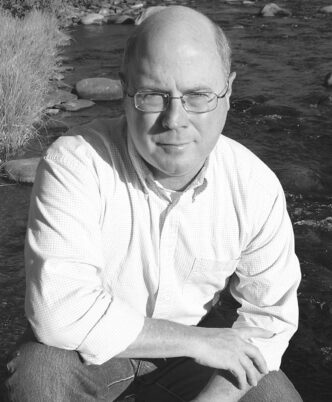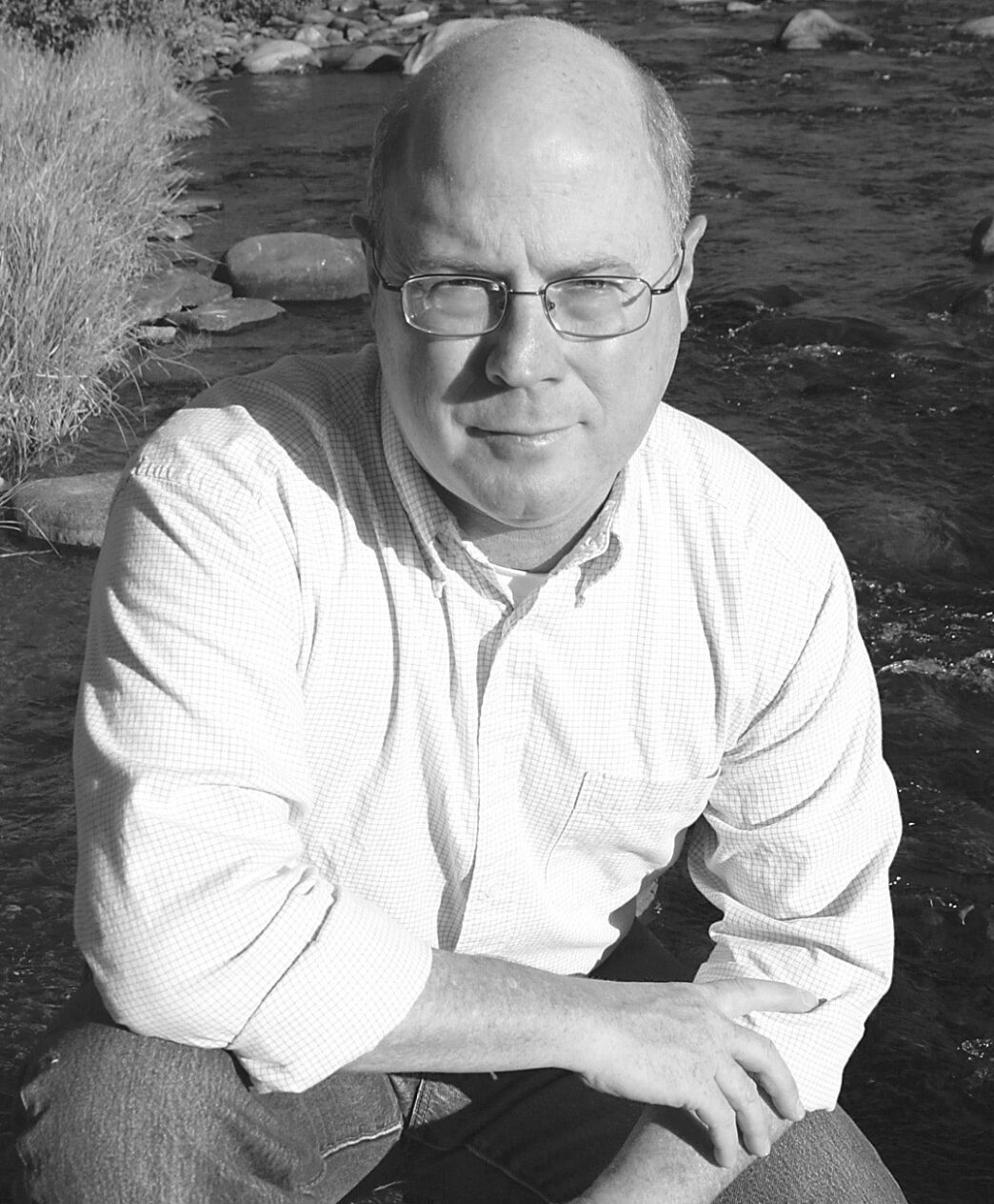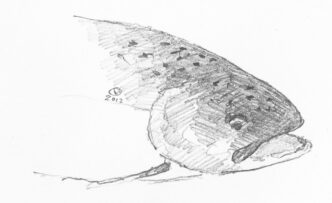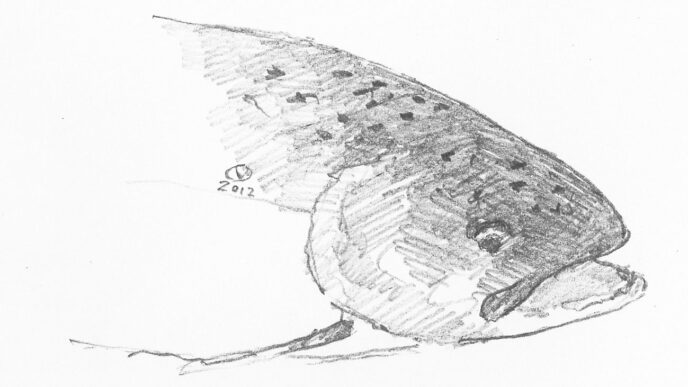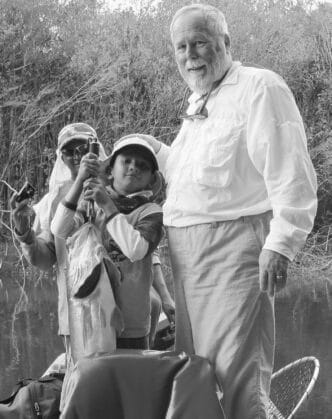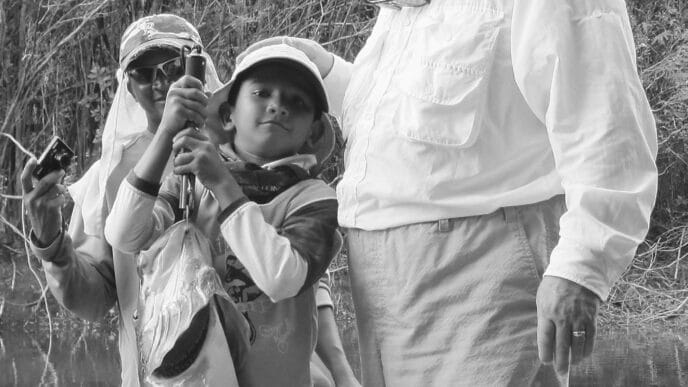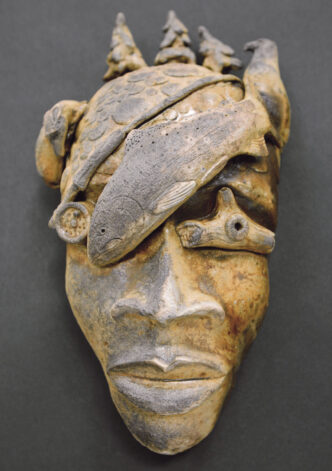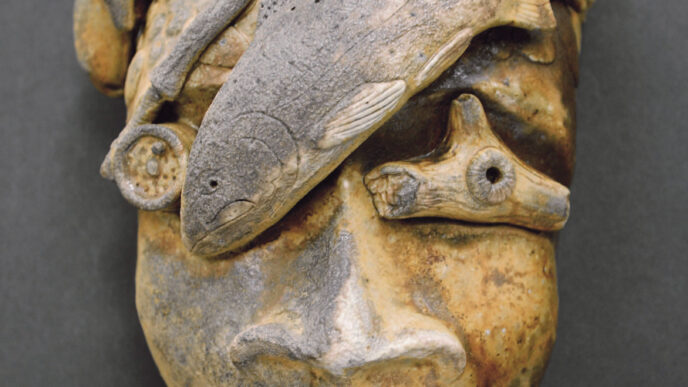I wish I could just say that Richard Anderson, the publisher and editor of California Fly Fisher, “needs no introduction,” but he does. Richard has so relentlessly kept himself out of the spotlight while steering the magazine through the sometimes muddy waters of the fly-fishing business for the last two decades that most readers probably know little about the man ultimately responsible for enriching their knowledge and enjoyment of the sport every other month for all these years. The twentieth anniversary of the magazine, however, provided the occasion for us to drag him kicking and screaming (but not both at the same time — he’s too nice for that) out from behind the curtain of the masthead and sit him down for an interview. Folks, here’s the guy who makes it all possible.
Bud: In the magazine’s editorials, when you’ve occasionally mentioned your youth in Long Barn, in Tuolumne County, it tends to convey something of a “barefoot boy with cheek of tan” existence. I know Long Barn chiefly from having blown past there on Highway 108 on the way to somewhere else. But I also know that you were actually born in Oakland, went to high school in Livermore, and from there to San Jose State for a degree in environmental studies and then to Harvard for a master’s in city and regional planning. How is the child the father to the man — that is, what links Long Barn, college, and career to finally publishing California Fly Fisher?
Richard: I’ll start by saying that my life has pretty much been unplanned, that my “career path,” if it can be called such, has been influenced, in ways that are obvious and in ways that I still only partially understand, by the places I’ve lived, by family and friends, by the cultural milieu that surrounds us all, and by chance and serendipity. Probably the most important factors revolve around my childhood in the Sierra.
My mother and father had divorced by the time I entered kindergarten, and three years later, Mom decided to escape the Bay Area entirely and moved our family — which consisted of me, my twin brother, and my sister — up to the town of Long Barn, where a friend of hers had a cabin. It was an interesting choice for a move. The community, which sits at 5,000 feet and is roughly half an hour’s drive east of Sonora, was postage-stamp small, with fewer than two hundred people, a two classroom schoolhouse for six grades, and a mere handful of tourist-related businesses. I suppose it had been something of a vacation destination of note back in the 1920s, because much of the housing stock dates to that period, but by the time we got there, the glory days were long gone — although the main lodge in town, Long Barn Lodge, was still doing relatively well and even expanding.
For an eight-year-old, Long Barn was an extraordinary place — lots of uninhabited forest for adventures, and really, very little adult supervision. We spent huge amounts of time in the woods, becoming familiar with the terrain and, in a way, taking possession of it by exploring, building forts and hideaways, hunting critters with BB guns, catching frogs. I learned to fish, and I learned in the best way, by doing it myself and figuring out what worked and what didn’t.
Looking back, it was truly an idyllic rural/mountain childhood. Of course, like many kids, my brother, sister, and I didn’t at the time comprehend the richness of the natural world around us, but luckily, our TV could receive only three stations, which forced us outside and also into other activities, such as reading. In fact, I was discovering that the written word could open the imagination. This is important, because it’s a thread that leads to California Fly Fisher.I began buying comic books at the local general store, I read the entire set of Tom Swift and Hardy Boys books in our school library, and by the time I was 10, I had started into “grownup” literature, science fiction mostly, from the three shelves of public-library books stored in a cabinet at the local post office.
When I finished sixth grade, Mom married a fellow who had a small cabin across from one of the three watering holes in town. John Kimlinger was a mathematician and computer programmer at the Lawrence Livermore Laboratory, and that summer, 1967, we left the mountains for a ranch-style tract home in Livermore, joining the multitudes who were similarly moving to the California suburbs. Although folks liked to think of Livermore as a sleepy, semi-rural town surrounded by vineyards and ranches, its population was approaching thirty thousand, and many of the residents were nuclear scientists, weapons engineers, and the techies who supported both. It was also a town filled with kids — the Baby Boomers — and the diversity of backgrounds and interests pretty much assured that the newbies in school, like me, would quickly end up with friends. None of my friends fished, however, and although our family kept the place in Long Barn, and although I fished with John and later received a fly rod and hand-me-down fly tackle from my grandfather, David Anderson, in high school my love for fishing waned, especially given that if I wanted to fish locally, I had to (and did, once) trespass into the gravel pits west of town.
You asked how college relates to all this. Here’s where serendipity, perhaps, comes into play. The public schools in Livermore were very good, and my brother and sister and I were raised with the expectation that we were going to college, even if I didn’t exactly understand why I would want to do so. So as a senior in high school, I applied to and was accepted by U.C. Santa Barbara and San Jose State. Both had Army R.O.T.C. programs, and at the time, I thought I might want to become a military officer. But really, I was extremely naïve and innocent of the world. I ended up choosing San Jose State because it was inexpensive enough that I could cover my half of the cost by working only during the summer, rather than the entire year, my parents being willing to cover the other half. I had been indifferent about high school, but I absolutely loved college. Within a semester, I realized that I enjoyed learning, I enjoyed having responsibility for both my life and my future, and I also enjoyed, ironically, having no responsibility other than to try to understand the world around me. I did well in R.O.T.C., joining the Pershing Rifles military fraternity, the drill team, and the cadet Rangers and receiving a scholastic honors award and, at the end of the school year, the Superior Cadet award as the top cadet in the freshman class, which surprised me, because others seemed at least equally deserving. But by this time I also realized I had no strong interest in serving in the military, so I made the momentous decision to leave the cadet corps.
This meant that I needed to find another reason for being in school. My initial major had been political science, but I had chosen it merely as a placeholder. It was time to make a serious choice. Because of my interest in the outdoors and the influence that Long Barn and the Sierra had on my values, I gravitated to a new multidisciplinary program called Environmental Studies.
In the program, I took a number of courses in geography and came to understand the huge role that land use plays in affecting the natural world, both locally and globally, and I also became curious about how communities evolve and how we could make them better places in which to live. I began taking classes in city planning and planning-related subjects such as urban economics, found the subjects fascinating, and decided to continue on to graduate school, which would help ensure that I would be able to put my education to use and, importantly, receive an income.
Because I was basically dirt poor and my parents said grad school would be entirely on my dime, I applied to affordable in-state programs at Berkeley, San Jose State, and San Diego State, knowing that I’d be able to figure out how to pay for them. However, my faculty advisor suggested I also apply to the Harvard Graduate School of Design, which at the time, 1977, was expanding its City and Regional Planning Program. What the heck, why not? I scrounged up the application fee, typed up the essays, and sent off transcripts and recommendations.
Astonishingly, Harvard accepted my application. There of course was no question that I wouldn’t take advantage of this opportunity. I received a sizeable student loan and off I went, a quasi-hippie wearing Earth Shoes and bell bottoms, to Cambridge, Massachusetts. It was an extraordinary two years. I discovered I could do well in an Ivy League scholastic environment, and what we were learning was exciting, too — analytical and conceptual tools that would allow us to better understand both the forces that shape communities and the impacts that governmental policies and programs might have.
This brings in another important thread that pertains to California Fly Fisher. Because we would likely be working for public agencies, great stress was placed on writing clearly and succinctly for a lay audience. Each week we usually had to prepare a three-page, double-spaced memorandum that would present an argument for a policy decision to a hypothetical employer — usually a mayor or city manager. I had always enjoyed writing, but these exercises definitely improved my chops.
Upon graduation, I returned home and got a job with San Joaquin County. But this was a year after Proposition 13 passed and more such measures were being floated. It seemed to me there might not be much of a future in the public sector. I switched over to consulting, working for several companies that specialized in a field called land economics. Basically, we were advisors to developers and to communities that wanted more development. At first, the work was interesting, simply because you were applying the tools you had learned to figure out whether a piece of land was most appropriate from a market perspective for, say, a shopping center or an industrial park, but the impetus in consulting is to bang out the report and move on to the next job. Too many times, the work was rote, boring. And I had traveled far from my initial motivations for getting into planning, which were to reduce our impact on the natural world and to create better places to live.
My father, a contractor, noticed my unhappiness and invited me to come to work for his company, which I did, and I could fill a book with lessons learned. But with regard to California Fly Fisher, here’s where chance comes in. At the time, I was living in San Francisco, and a friend, Bob Dahlberg, who worked in marketing in Silicon Valley, had broken his fly rod and asked me to drop it off for repair at the manufacturer, Scott Powr-Ply, which was situated on a narrow alley, Clementina Street, “south of the slot” in the city. I had not fished in twelve years, but walking into the factory, the old urge welled up, and when I returned to pick up Bob’s rod, I asked the manager, a fellow named Larry Kenney, if he had any “seconds” he could sell me. “Possibly…” he said, pulling out a nine-foot 5-weight and pointing to a spot where I still can’t detect a blem. “Twenty percent off.” I bought it. If it hadn’t been for Bob’s request, I very likely would not have returned to fly fishing.
Bud: Your byline here reads “Publisher and Editor,” but you started out as a writer, publishing Trout the Size of Footballs, an angler’s odyssey disguised as a survey of Western trout streams, to put it in Blurbese. How did that come about, and how did you metamorphose into a “Publisher and Editor” from a writer? It’s after all a bit like becoming a guide — you don’t actually get to do much of what you used to do, instead helping others do it.
Richard: To be clear, I started out as a fisher, then a reader. The writing came later, much later, and mostly because I was a fisher and a reader. One of the genres I enjoy reading is first-person travelogues that immerse you in the experience and contemplation of place — much as angling literature can likewise immerse the reader in the experience and contemplation of sport. In the 1980s, there was a tremendous increase in travel writing, with publishers creating book imprints such as Vintage Departures and new magazines to meet the demand for this type of literature. Even the retailer Banana Republic launched a travel magazine, Trips, although it lasted only one issue. Fly-fishing magazines were likewise publishing travel essays (had been for a while, actually); I still remember a piece on Canada’s Bow River, written by Harry Campbell and published in Rod & Reel magazine, that strongly affected my desire to fish that river.
This was the period when I was working for my father’s construction company in Oakland as an estimator and project manager, mostly in the insurance repair division. It was interesting, creative work — you were always competing against other contractors, which meant trying to figure out, for example, how much of a burnt structure could be saved, rather than rebuilt, the latter being more expensive, and you also had to keep the property owner happy and the insurance adjuster satisfied that expenses were reasonable. My father at this point had spent decades in the business and was looking to retire. He wanted to sell the company to a partnership that consisted of the three project managers, but because of divergent personalities and lack of trust, we couldn’t get our act together, so he ended up closing the doors. It was both a disappointment and a relief in that the bickering and uncertainty were over, and I decided to take advantage of the loss of employment by spending the summer fishing the West. I bought a beat-up ’69 Chevy pickup from the company, installed a similarly beat-up camper shell that I borrowed from a carpenter friend, carpeted the bed of the truck, added a mattress, camping gear, fly tackle, a box of books, and off I went. This was June of 1988.
I was back home by the end of August, having fished eight states and two Canadian provinces and driven in excess of nine thousand miles. Along the way, I had jotted down notes of my experiences, because, frankly, there wasn’t much else to do around the campfire. “ Why not try to write a book?” I thought as I examined the scraps of paper, store receipts, and disassembled grocery bags over which my handwriting was scrawled.
It was an ambitious idea. I had never published anything — had never even tried to write “creatively,” other than as assignments in school. I had, however, written many consultant reports, but unless you were a numbers wonk, those were uniformly boring documents, chock full of declarative and passive sentences that within three pages could cause the eyelids of an insomniac to droop.
So for several months, I actually lived the supposed life of a writer, typing during the morning and into early afternoon, then often going on long strolls through San Francisco. I was also fishing a lot, exploring the opportunities — and there are a lot of them, if you’re willing to put aside biases and think creatively — in the Bay Area, as well as visiting the Sierra and the myriad waters spread around Redding.
When I finished Trout the Size of Footballs, as the book came to be titled, I began sending it off to publishers. Frank Amato, whose Portland, Oregon, company publishes angling magazines and books largely slanted toward the North American West, decided he’d take a risk and put it out, for which I am forever grateful. Whatever one thinks of the quality of Footballs — and, in looking back on it, there are sections of the book that I remain happy with and sections that could’ve used more editing — I thus became a writer.
But writing, especially writing for the angling market, doesn’t necessarily provide an income that’ll pay the bills. Once I realized how many books I would likely sell, and therefore what my royalties would total, I went back into consulting so as to have a livelihood. This was, oh, around 1990, and I was 35. But the writing bug had bit, and within months, I realized I would never be happy doing the same ol’ same ol’. I was in a position with regard to savings and responsibilities that would allow me to take an entrepreneurial risk. But what to do?
Hmm, I liked hoisting a pint or two with friends; how about opening a pub? Nah — I really didn’t want to be on my feet at two in the morning in a smoky room with mostly drunks for company.
Hmm, I visited the newsstands every month, looking for stories on California fisheries and rarely finding anything, and I was a competent, curious fly fisher with an interest in writing, angling literature, and graphic design — why not launch a California-focused fly-fishing periodical?
Bingo!
And thus, in September of 1992, with the appearance of the first issue of California Fly Fisher,I formally became “Publisher and Editor.” Although I want to acknowledge here, Bud, the critical role you play as first-round editor who handles the hard work of getting manuscripts into shape for my review as second-round editor.
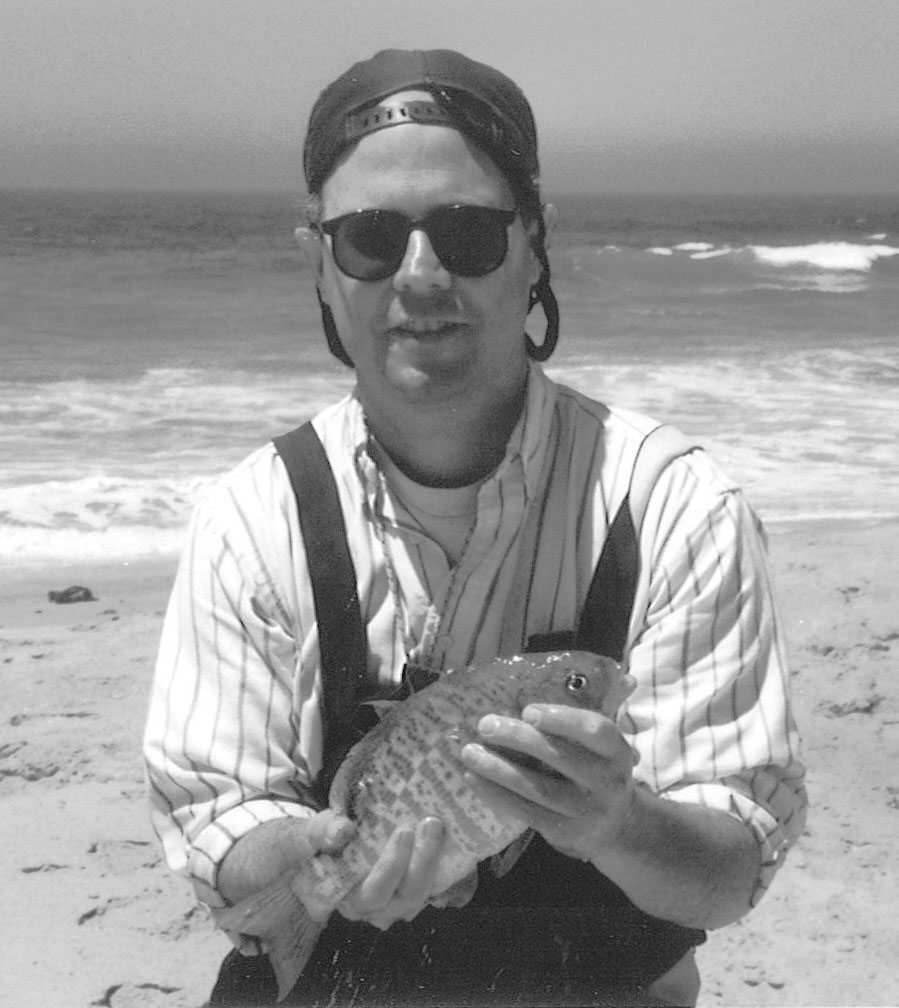
Bud: Aw . . . thanks (blushes) . . . but don’t you try to dodge back behind the curtain. The very first interview I ever conducted for the magazine, even before the column was called “California Confluences,” was of Ken Hanley (for the March/April 2003 issue; it’s also the origin of the Silly Tree Question). There, he recounts his version of the magazine’s Genesis narrative. It’s not quite biblical — more like Hewlett and Packard together in a garage — but it does involve the trinity of you, Kenny, and Seth Norman. What’s your version?
Richard: OK, this is my version without rereading what Ken had told you. During the spring of 1992, I was fleshing out the concept for California Fly Fisher while also fishing heavily. During a visit to the late Larry Kovi’s store in Larkspur, Selective Angler, I spotted a notice on the wall for a saltwater fly-fishing clinic being held at a coastal marine preserve in San Mateo County and hosted by a fellow named Ken Hanley. Up to that point, I had spent around eighty hours fishing the surf, with only one surfperch and a jogger for my efforts. So I of course signed up. And it was hoot. Ken not only is good-natured and generous, he’s enormously enthusiastic, and the four of us participating in the clinic caught his enthusiasm, which actually is very useful when faced with the immensity of the Pacific Ocean and what at first is an unreadable line of crashing waves. Most critically, however, we landed fish. Ken and I got to talking during lunch — I still remember it: clam chowder, Anchor Steam, and sourdough at some joint in Half Moon Bay — and he mentioned he was thinking about starting a fly-fishing publication. I’m not sure if he had gotten very far into the concept, and he had other responsibilities, too — a wonderful family and, if I recall, work as a teacher — but I was very impressed with Ken’s expertise as a surf-zone fly fisher, and Frank Amato had published a book of his a year earlier, California Fly Tying and Fishing Guide, so he clearly had ability as a writer. (I don’t think his Fly Fishing Afoot in the Surf Zone had yet come out, which might have been the publication he was referring to when we were talking.) It made sense to bring him on board, so I told Ken of my plans, and he ended up pitching the idea of an advice column called “Tips ’n’ Tugs,” which later morphed into “California Confluences,” and he also contributed a feature to the first issue and others after that. His influence on the early magazine was significant, and through his talent he has gone on to write a number of fine fly-fishing books and become both a regular on the fly-fishing show circuit and a well-regarded professor of hospitality, tourism, and recreation at California State University East Bay.
As for Seth, I met him at the Oakland casting ponds, where I think we were both working on our double haul. Seth, being the sort of gregarious person who can get a stone to talk, started up a conversation. At some point, I mentioned I’d recently had a fly-fishing book published, and Seth in turn noted he was a writer and had a piece in the East Bay Express that had been nominated for a Pulitzer. This intrigued me, and he was witty and obviously largehearted, and I somehow wound up with his card. As California Fly Fisher began taking form, I gave him a call. He came on board with “The Master of Meander,” which turned out to be exactly the sort wide-ranging, provocative column that I was seeking, although I didn’t know it until Seth sent the first installment. As with Ken, Seth has had an important influence in setting the tone and direction of the magazine, and it’s hardly surprising that his columns and other works have been collected into two books published by Lyons Press and that he was picked by Fly Rod & Reel to serve as their book reviewer.
Bud: Over the years, you’ve assembled quite a cast of characters — and I mean that in all the possible senses of the term — as regular contributors: not just Ken and Seth, but Andy Burk, Rick Bean, Ralph Cutter, Tom Martens, Larry Kenney, Bill Carnazzo, and a series of Foraging Anglers up to Trent Pridemore. (Apologies to all the others I don’t have space to list.) Some, such as Seth, Scott Sadil, and Michael Checchio, were writers of serious literary merit who were in the early stages of their careers and who have all obtained national prominence, and others, such as Bill Barich and (as in the current issue) Russell Chatham, come to the magazine with established national reputations. How and where do you find people like that?
Richard: It’s rarely me finding them, but them instead finding California Fly Fisher. As to why they contribute, you’ll have to ask each writer, but I hope it’s because they recognize that this is a magazine created by enthusiasts for enthusiasts and that our focus is, first and foremost, the quality of the writing and the heart within it.
By the way, I’d like to include Barry Glickman on your list of notable characters who have contributed to the magazine. Jazz musician, painter, finish carpenter, fly tyer extraordinaire, dry-fly aficionado, and one heluva a fine illustrator, Barry drew the fly that graced each “At the Vise” column before we decided to go to photographs. In my opinion, he is the finest fly illustrator in the country, and his work, appropriately, graces the pages of John Gierach’s book about favorite patterns, Good Flies.
Bud: Before there was California Fly Fisher, you had a multiyear career as a consulting land economist and planner, and even during that time, as well as since, you’ve been involved in public policy issues, especially focusing on conservation issues, early on winning California Trout’s President’s Streamkeeper Award, for example. Since then, you’ve done yeoman work on water issues in the Martis Creek drainage, been elected to the Truckee Town Council, served as mayor of Truckee, and just recently, you ran successfully for a seat on the Nevada County Board of Supervisors. What’s the relationship between publishing an angling magazine with a strong conservation component and your public policy career?
Richard: I am a conservationist in large part because I fish, and I believe that an angling magazine must necessarily take a conservationist tack if we’re to have even adequate sport in the future. And if I’m going to talk the talk, then I need to walk the walk. I’ve long been involved as a volunteer and donor, and I’ve personally stood up for our fisheries, most notably with regard to Martis Valley, where proposed land development threatened — and continues to threaten — Martis Lake, which when I moved to Truckee in 1999 was still a productive and fun wild-trout fishery. Ironically, although I’ve never seen myself as a particularly political person, the experience convinced others in Truckee that because I seemed a reasonable and thoughtful person and had a working knowledge of the intricacies of land-use planning and local government, I would be a suitable candidate for the Truckee Town Council. Over time, these folks managed to convince me, as well, but I have to admit that part of my motivation to run was that I was curious as to whether a person without political ambition could in fact win the seat and then do a credible job filling it. I’ve now won three elections, which I suppose answers the first question and maybe the second one, too.
But the truth of the matter is that like most people, I’m uncomfortable with the stereotypical role of the politician. I’m awkward at slapping backs and kissing babies. I tend to say what I think. I don’t have a burning desire to be popular. But I strongly believe that involvement in government, whether it’s merely paying attention to the decisions made or stepping in it all the way and running for office, is extremely important. Involvement is, in a way, a form of home maintenance. Where we live is not simply a parcel with a house on it. Home also includes the roads that connect our house to others, the stores nearby where we shop, the schools and libraries and parks that we frequent, the church we might attend, the bar where we stop to lift a glass with friends. Home includes our broader community, and it’s both the natural and the built environs that surround us and sustain us. If you think about it in that manner, why wouldn’t someone want to get involved?
Bud: The past twenty years have seen major changes in the field of angling publishing — including book publishing, which you’ve been involved in via your own imprint, Aguabonita Books. How have you dealt with these changes? Ever think of expanding? Gertrude Stein once proposed writing a book about how each state differs from the one next to it, and in that vein, what about an Oregon Fly Fisher … Nevada Fly Fisher … and on and on?
Richard: Probably the most interesting change is the growth in the number and variety of channels, so to speak, through which fly fishers receive information. Anglers no longer rely just on print media and radio and television shows, but are using Internet bulletin boards, blogs, YouTube videos, and podcasts for learning where and how to fish. To ensure that California Fly Fisher remains successful, we need to pay attention to these changes, understand their implications, and act when necessary to meet new challenges, which by their very technological nature are continually evolving. This is actually a very exciting time. Of course, as a small media company that focuses on a niche of a niche, it’s difficult, if not in fact foolish, for California Fly Fisher to place itself at the leading edge of media technology. But the magazine’s subscription renewals and over-the-counter sales continue to indicate that we’re doing a good job, and if we can move into other media and similarly achieve success, then we’ll do so. Right now, however, everyone in publishing is “feeling the elephant,” trying to figure out what’s going on and how best to capitalize on these evolutions without also going under. I dislike gambling, so I prefer to watch what the big boys do and learn from their successes and their errors before committing to a course of action.
As for expansion into other regions, yes, I’ve thought about it. And am still thinking about it. Enough said for now.
Bud: Other than media, what are the top three changes in the fly-fishing industry over the last twenty years, and what has stayed pretty much the same?
Richard: Apologies, Bud, but I just finished a political campaign back in June that had me constantly addressing questions like “What are your top three ways to invigorate our local economy?” So I’ll take a different tack here. I’ll briefly note that trends in the industry include the entry of bigbox stores into the fly-fishing retail scene, the offshoring of much manufacturing, fly shops branding their own gear, manufacturers selling direct to the consumer, and the rise of the fly-fishing “pro,” largely young men and women who work in fly shops and as guides and who have become a subset culture within the broader culture of fly fishing.
In fact, it’s the cultural changes, rather than those in the industry, that I find most interesting. Here’s what I mean. At The Fly Fishing Show in Pleasanton last winter, one of the exhibitors was selling T-shirts that displayed a huge mayfly sitting atop the silhouette of an assault rifle. The image was so discordant with how we usually view the sport, more Johnny Rotten than John Muir, that it stopped me dead in my tracks — what on earth was it trying to say? Other items in the booth referred to gangsta culture. Was this the logical conclusion to the sort of punkish, aggro attitude being used to market outdoor products to the youth demographic?
This fascinates me, particularly because fifty years ago, in his “Testament of a Fisherman,” Robert Traver wrote of fishing that it is an “act of small rebellion,” a way to escape “television commercials, cocktail parties, and assorted social posturing.” But a lot of folks today, the kids included, are only about posturing. They aren’t raising their fists in protest — they’re opening their wallets to buy. If you really want to be a badass, then show some cojones and stand up in front of a planning commission or city council and fight the projects that are screwing up our fisheries.
Bud: And here we are at the dreaded Silly Tree Question: If you were a tree, what kind of tree would you be?
Richard: The mountain hemlock. Common in the Pacific Northwest, it’s rarer in California, growing mostly on north-facing slopes at high elevation near the timberline. The mountain hemlock’s drooping crown and branches remind me of a priest giving benediction, which would actually be a very nice thing for a tree to do.



